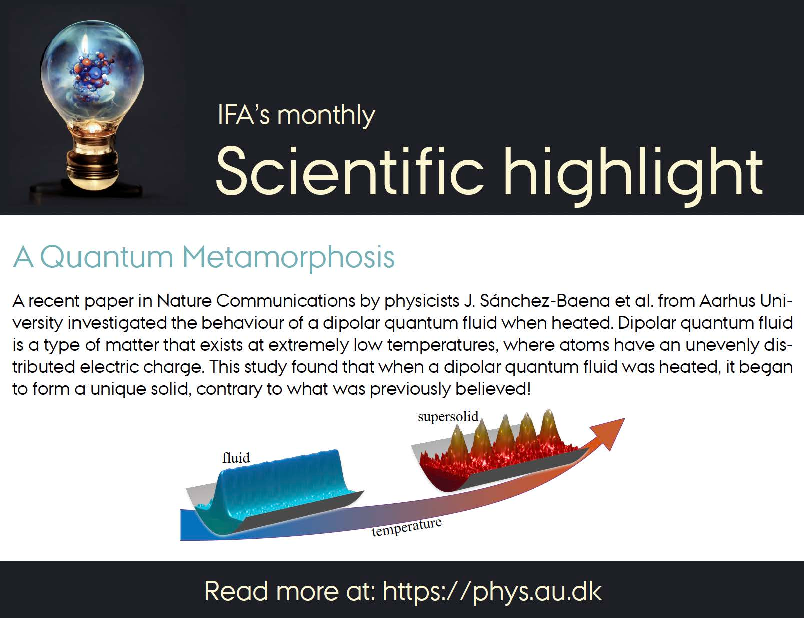Scientific Highlight - April 2023
Title: A Quantum Metamorphosis

A recent paper in Nature Communications by physicists J. Sánchez-Baena et al. from Aarhus University investigated the behaviour of a dipolar quantum fluid when heated. Dipolar quantum fluid is a type of matter that exists at extremely low temperatures, where atoms have an unevenly distributed electric charge. This study found that when a dipolar quantum fluid was heated, it began to form a unique solid, contrary to what was previously believed! This research provides new insights into the behaviour of dipolar quantum fluids and could impact the development of new materials and technologies.
“The physics of dipolar quantum fluids have already revealed many surprises, but we did not at all expect that these fluids could solidify upon heating.”
- Thomas Pohl, who led the theoretical efforts at Aarhus University.
We typically do not hear of a liquid changing to a solid when heated. This was also expected from dipolar quantum fluids because as per our intuition, the heat turns a solid into a liquid and eventually vaporizes the formed fluid. However, researchers J. Sánchez-Baena, C. Politi, F. Maucher, F. Ferlaino & T. Pohl found very surprising results in their experiments on ultracold dysprosium atoms. These atoms refer to atoms of the element dysprosium that have been cooled to extremely low temperatures using specialized cooling techniques. When the atoms are cooled to near absolute zero, they enter a quantum state known as a Bose-Einstein condensate (BEC), where they behave as a single entity and exhibit unique quantum phenomena such as superfluidity and coherence.
In this study, researchers found that the superfluid BEC state underwent a change to a “supersolid” state when the temperature was raised. A supersolid is a state of matter that has both the properties of a solid and a superfluid. In a superfluid, atoms or molecules are able to flow without any resistance, while in a solid, atoms are arranged in a fixed pattern and have a fixed shape. This surprising behaviour of fluid-solid transition arises from the anisotropic dipole–dipole interaction.
“Studying this effect has raised many more questions and I hope we will be able to use our recent insights and resolve some of these remaining mysteries.”
- Juan Sánchez Baen (Aarhus University), first author of the paper.
Raising the temperature of a dipolar quantum fluid can trigger a phase transition to a solid state of matter. Heating normally tends to melt or vaporize a material, but in a dipolar quantum fluid it can generate a supersolid, composed of mesoscopic quantum droplets that arrange in regular structures. (Courtesy: Thomas Pohl)
Let’s unpack what anisotropic dipole-dipole interaction means. It is the interaction between two particles that have electric charges that are not evenly distributed, which causes them to act like tiny magnets. The term "anisotropic" means that the interaction is directionally dependent - that is, the strength and direction of the interaction depend on the orientation of the magnetic dipole moment of each particle relative to the other. The dipole-dipole interaction can be attractive or repulsive, depending on the orientation of the dipoles. When they are parallel, the interaction is attractive, but when they are antiparallel, the interaction is repulsive.
The study also describes in detail the theoretical aspects, experiments conducted and imaging techniques, including the use of a magnetic field to manipulate the atoms and observe their behaviour. The findings of this study provide new insights into the behaviour of dipolar quantum fluids and have fundamental implications for our understanding of the thermodynamics of quantum matter, which may impact the future development of new materials and technologies
